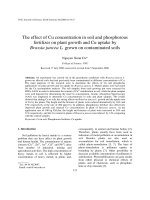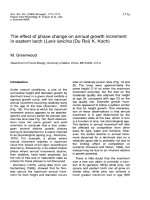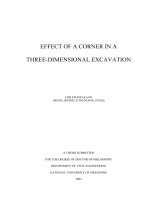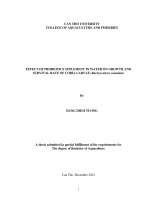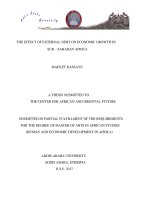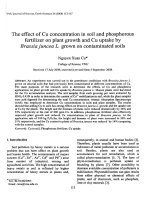Effect of Trichoderma spp. in plant growth promotion in chilli
Bạn đang xem bản rút gọn của tài liệu. Xem và tải ngay bản đầy đủ của tài liệu tại đây (249.39 KB, 8 trang )
Int.J.Curr.Microbiol.App.Sci (2019) 8(3): 1574-1581
International Journal of Current Microbiology and Applied Sciences
ISSN: 2319-7706 Volume 8 Number 03 (2019)
Journal homepage:
Original Research Article
/>
Effect of Trichoderma spp. in Plant Growth Promotion in Chilli
Ashish Kumar1*, Akhilesh Patel2, S.N. Singh1 and R.K. Tiwari2
1
Jawaharlal Nehru Krishi Vishwa Vidyalaya (JNKVV) College of Agriculture,
Jabalpur, M.P. 482 004
2
Jawaharlal Nehru Krishi Vishwa Vidyalaya (JNKVV) College of Agriculture,
Rewa, M.P. 486 001
*Corresponding author
ABSTRACT
Keywords
Chilli,
Trichoderma, Root
length, Shoot
length, Yield
Article Info
Accepted:
12 February 2019
Available Online:
10 March 2019
Trichoderma species are commonly used as biological control agents against
phytopathogenic fungi and some isolates are able to improve plant growth. In this study,
the effects of seven Trichoderma isolates from Madhya Pradesh was examined in chilli for
enhancing seedling and plant vigor via two way introduction methods (inoculating seed
with Trichoderma as seed treatment and also seed treatment with three foliar sprays).
Different isolates of Trichoderma spp. significantly influenced the root length, shoot
length and number of leaves of chilli at seedling stage. The maximum root length and
shoot length of 6.22 cm 7.33 cm respectively was recorded in seed treatment with
Trichoderma isolate T2. Similarly, the same isolate T2 depicted maximum number of
leaves (8.70 per plant). Further, enhanced plant growth promotion activity was shown by
isolates of Trichoderma when applied as seed treatment coupled with three foliar sprays. It
was observed that maximum root length (6.84 cm), shoot length (62.19 cm), number of
branches (5.82) was depicted in seed treatment coupled with its three foliar sprays of T2
isolate of Trichoderma. This was followed by T5 isolate of Trichoderma. Similarly,
maximum fresh and dry weight (biomass) was recorded in T 2 isolate of Trichoderma.
Application of different isolates of not only significantly contributed to foliage of the chilli
plant but they also enhanced the yield component of chilli. The maximum yield of 69.55
q/ha was recorded in treatment T2 where Trichoderma isolate T2 was applied as seed
treatment along with its three foliar sprays.
Introduction
Chilli (Capsicum annum L.) is an important
spice cum vegetable crop, often referred to as
Capsicum, hot pepper, sweet pepper or
paparika. Chilli cultivation has existed for
several hundred years as a sustainable form of
agriculture in India and in many other
countries. It is an annual herbaceous vegetable
and spice grown in both tropical and subtropical regions. India accounts for 25% of the
world’s total production of chilli (Ashwini and
Srividya, 2014). Trichoderma, a filamentous
soil inhabiting mycoparasite, is used in
commercial preparation for biological control
of many fungal plant pathogens (Jash, 2006)
1574
Int.J.Curr.Microbiol.App.Sci (2019) 8(3): 1574-1581
and included the mechanisms like antibiosis,
competition for nutrients or space, tolerance to
stress through enhanced root and plant
development, induced resistance, solublization
and sequestration of inorganic nutrients and
inactivation of pathogen enzymes (Harman,
2000). However, with the increasing interest
in biological control, owing to environmental
and economic concerns, and with the rapid
development of biotechnology, several
Trichoderma species were formulated in a
commercial production for protection and
growth enhancement of a number of crops in
several countries (McSpadden and Fravel,
2002). Beside the other necessary factors in its
growth, it makes better support for shoot
growth and development. The effect of
Trichoderma isolates on plant growth and
development is important, especially in
nursery, because improvement of plant vigor
to overcome biotic and/or abiotic stresses
results in the production of stronger plants and
increase in plant productivity and yields.
Trichoderma being a soil fungus, its growth,
multiplication and eventually its biocontrol
potential is highly affected by various soil
physical, chemical and biological properties.
They are reported to be affected by factors like
soil pH, soil temperature and moisture level,
water potential and most importantly by the
activities of the native antagonistic microflora
which is present in the soil where they are
applied as biocontrol agents (Bull, 2002).
Therefore, it becomes important that the
selected strain should have the ability to
compete with the native microflora, establish
itself successfully in the crop rhizhophere/
spermosphere and should have a wide array of
mechanisms to inhibit several pathogens.
Given these considerations, it is expected that
the best method for obtaining a potential
biocontrol agent might be to isolate
Trichoderma strains originally from those
areas where they are actually expected to
function later as a biocontrol agent and where
they are already growing under conditions of
temperature, moisture etc. similar to those
found in nature (Howell, 2003).
There are relatively few strains of
Trichoderma that have the ability to stimulate
plant growth response (Lo and Lin, 2002). The
most beneficial Trichoderma strains that are
able to colonize the root and inhabit the
rhizosphere are known to have the
"rhizosphere competence" (Harman et al.,
2004). Therefore, screening of Trichoderma
isolates is beneficial in enhancing plant
growth and development, which is highly
desirable in order to reduce or eliminate the
use of synthetic chemical fertilizers from the
point of the view of sustainable agricultural
system because application of man-made
fertilizer is not economical in the long run for
environmental pollution, due to the fact that
harmful residues and their highly application
cost are left in the soil.
Therefore, information on plant growth
promotion activity of different isolates of
Trichoderma is an important aspect of
research not only for coping up with diseases
but also to reduce fertilizer application and
enhancing plant growth and yield in an ecofriendly manner.
Materials and Methods
Trichoderma harzianum isolates
A set of seven isolates of T. harzianum were
procured from Department of Plant Pathology,
College of Agriculture, Rewa and used in the
present investigation. All of these isolates
were isolated from Satna, Rewa (Kuthulia),
Khargone, Indore, Umaria, Rewa (Birkham)
and Sidhi locations of Madhya Pradesh and
coded as T1, T2, T3, T4, T5, T6 and T7
respectively. The procured isolates of T.
harzianum were maintained throughout the
study by periodical transfers on Potato
dextrose agar (PDA) medium.
1575
Int.J.Curr.Microbiol.App.Sci (2019) 8(3): 1574-1581
Plant growth promotion activity in chilli
Plant growth promotion activity of T.
harzianum was studied in experimental area of
Department of Plant Pathology, J.N.K.V.V.,
College of Agriculture, Rewa. The seeds of
chilli cv. Kohinoor special were obtained from
Department of Plant Pathology, College of
Agriculture, Rewa. Further, seeds were sown
in lines at a spacing of about 5 cm apart on
raised beds of about 15 cm above ground level
and covered with soil, thereafter, mulched
with dry grasses. Proper moisture was
maintained for the growth of the seedlings.
After germination of the seedlings, the dry
grass was removed to expose the seedlings to
sunlight for better growth. The seedlings
were transplanted to individual plot size of
1.5 m × 2.5 m with row to row and plant to
plant spacing of .75 m and 0.30 m
respectively. For seed treatment slurry of
different isolates of Trichoderma was
prepared separately for each isolate and
seeds were treated @10 g/Kg seed. Seeds
were dipped in the slurry for 30 minutes
and dried in shade before sowing. For foliar
spray, the first spray was given 25 days
after transplanting followed by two more
sprays at 15 days interval. The spray
solution was prepared by adding 2.5 g
culture of Trichoderma separately in 1 litre
of water. In total seven treatments were
formulated using different isolates of
Trichoderma (T1 to T7) as seed treatment
and seed treatment with three foliar sprays.
Observations were recorded for different
parameters at seedling stage (before
transplanting) and after three foliar sprays of
respective Trichoderma isolate. Five plants
were randomly selected from each treatment
under each replication passing up the border
plants. The tagging was done before
flowering. Data were recorded on the tagged
plants for different attributes including plant
height (cm), root length (cm), no. of branches,
fresh weight of plant (g) and dry weight of
plant (g) after 10 days of last spray. Yield of
green chillies were recorded in each pickings
from all the plots including control. The total
yield of marketable fruits obtained from
different treatments was calculated and
converted to per hectare yield. The data
collected were subjected to Randomized Design
for their significance (Gomez and Gomez,
1984).
Results and Discussion
A set of seven isolates of Trichoderma spp.
(T1 to T7) were used for seed treatment and
foliar sprays in chilli. The plant growth
promotion activity was recorded for different
characters at the time of transplanting
(seedling stage) and after 10 days of three
foliar sprays.
Effect of seed treatment in plant growth
promotion at Seedling stage
Observations were recorded for root length,
shoot length, number of leaves and plant
vigour index at seedling stage after seed
treatment with different isolates of
Trichoderma spp. Different isolates of
Trichoderma spp. significantly influenced the
root length of chilli at seedling stage. Average
root length ranged from 5.55 cm to 6.22 cm in
seed treatments of different isolates of
Trichoderma spp. However, in control plants
average root length of 5.40 cm was recorded.
The maximum root length of 6.22 cm was
recorded in seed treatment with Trichoderma
isolate T2 followed by isolate T1 (5.83 cm).
The minimum average root length of 5.55 cm
was recorded in seed treatment with T6 isolate
of Trichoderma. The average shoot length of
chilli plants in seedling stage ranged from 5.83
cm to 7.33 cm after seed treatment with
different isolates of Trichoderma spp. In
control plants average shoot length of 5.53 cm
was recorded. This showed the plant growth
promotion activity in different isolates of
1576
Int.J.Curr.Microbiol.App.Sci (2019) 8(3): 1574-1581
Trichoderma spp. The maximum shoot length
of 7.33 cm was recorded in seed treatment
with Trichoderma isolate T2 followed by T1
isolate of Trichoderma (6.74 cm). Among
different seed treatments, the minimum shoot
length of 5.83 cm was recorded in treatment
T6 where chilli seeds were treated with T6
isolate of Trichoderma. Data related to
average number of leaves in chilli seedlings at
seedling stage revealed that maximum average
number of leaves of 8.70 per plant was
recorded in seed treatment with Trichoderma
isolate T2 followed by isolate T1 (7.93 per
plant). The minimum average number of
leaves of 6.93 per plant was recorded in seed
treatment with T6 isolate of Trichoderma.
However, in control plants 6.68 per plant
average number of leaves were recorded. The
detailed data for different parameters after
seed treatment with Trichoderma isolates
along with control has been given in table 1.
Effect of seed treatment and foliar spray in
plant growth promotion
Different isolates of Trichoderma spp. were
applied as seed treatment and three foliar
sprays at 15 days intervals to identify their
role in plant growth promotion in chilli. Root
length was measured after carefully uprooting
the plant and it was observed that different
isolates of Trichoderma varied significantly in
influencing the root length of chilli plant.
Average root length ranged from 5.73 cm to
6.84 cm in different treatments of
Trichoderma isolates. However, average root
length of 5.56 cm was recorded in control
plants. Maximum average root length of 6.84
cm was recorded in treatment T2 where
Trichoderma isolate T2 was applied as seed
treatment and its three foliar sprays. The
minimum average root length of 5.73 cm was
recorded in seed treatment and three foliar
sprays with T6 isolate of Trichoderma.
Further, average shoot length of different
plants ranged from 50.63 cm to 62.19 cm
among different treatments of Trichoderma
application as seed treatment and foliar spray.
However in control plants average shoot
length of 49.40 cm was recorded. The
maximum average shoot length of 62.19 cm
was recorded in treatment T2 where
Trichoderma isolate T2 was applied as seed
treatment and three foliar sprays at 15 days
interval. The minimum shoot length of 50.63
cm was recorded in treatment T6 among
different Trichoderma applications. In
different treatments average number of
branches ranged from 4.05 to 5.82. The
maximum average number of branches of T2
was recorded in treatment T3 where seed
treatment of Trichoderma isolate T2 was
coupled with its three foliar sprays. This was
followed by treatment T5 (5.63) where
Trichoderma isolate T5 was applied seed
treatment and its three foliar sprays. In control
plants, minimum average number of branches
of 4.05 was recorded. This showed the plant
growth promotion activity of Trichoderma
with varied level of response. The data related
to different plant growth promotion attributes
after seed treatment and three foliar sprays of
respective isolate of Trichoderma has been
presented in table 2.
Further, fresh and dry weight of plants was
recorded in all the treatments including control
to identify the enhancement in dry matter of
chilli plants in response of its growth
promotion activity. Data revealed that average
fresh weight of plants ranged from 90.50 g to
129.78 g in different treatments including
control. The maximum fresh weight of 129.78
g was recorded in treatment with Trichoderma
isolate T2 followed by isolate T5 (118.34 g).
Similarly, maximum dry weight of 32.25 g
was recorded in seed treatment along with its
three foliar sprays in Trichoderma isolate T2.
The minimum dry weight of 21.19 g was
recorded in control plants. However, among
different Trichoderma isolate, minimum dry
weight of 22.50 g was recorded in treatment of
1577
Int.J.Curr.Microbiol.App.Sci (2019) 8(3): 1574-1581
chilli plants with Trichoderma isolate T6.
Yield per plot measured in kg and converted
into quintal per hectare for all the treatments
including control. The data revealed that yield
ranged from 58.46 q/ha to 69.55 q/ha. The
maximum yield of 69.55 q/ha was recorded in
treatment T2 where Trichoderma isolate T2
was applied as seed treatment along with its
three foliar sprays. This was followed by
treatment T5 (68.27 q/ha) where Trichoderma
isolate T5 was used as seed treatment and
foliar spray. However, lowest yield of 58.46
q/ha was recorded in control. This
demonstrated the plant growth promotion
activity of Trichoderma when applied as seed
treatment and foliar sprays. The data related to
dry, fresh plant weight and yield of chilli in
different treatments has been presented in
table 3.
In the present investigation, a set of seven
isolates of Trichoderma, isolated from seven
different locations of Madhya Pradesh, were
evaluated for their plant growth promotion
activity in chilli with seed treatment alone and
also along with its three foliar sprays. Isolates
showed variable capacity of plant growth
promotion when evaluated upon different
parameters of root length, shoot length, plant
height, fresh weight, dry weight and yield.
Plant growth enhancement by Trichoderma
isolates is as a result of different mechanisms
such as exudation of plant growth regulators
and/or their similarity with the fungi (Hoitink
et al., 2006; Vinale et al., 2008), solubilization
of phosphates, micronutrient and minerals
such as Fe, Mn and Mg that have important
role in plant growth (Altomare et al., 1999),
secretion of exogenous enzymes, siderophores
(Jalal et al., 1987) and vitamins (Inbar et al.,
1994; Kleifeld and Chet, 1992), as well as
indirectly with the control of the major and
minor root infesting pathogens (Harman et al.,
2004) in rhizosphere. The variety of some of
these mechanisms indicate multiple modes of
action (Harman, 2006; Harman et al., 2004)
that lead to increase in nutrient availability
and uptake, resulting in the stronger nutrient
uptake by plant, and thereby developing the
root system.
Table.1 Effect of different isolates of Trichoderma on root length, shoot length and number of
leaves at seedling stage
Treatment
T1:Seed treatment with Trichoderma isolate T1
Root
length(cm)
5.83
Shoot
length(cm)
6.74
No. of
leaves
7.93
T2:Seed treatment with Trichoderma isolate T2
6.22
7.33
8.70
T3:Seed treatment with Trichoderma isolate T3
5.73
6.63
7.82
T4:Seed treatment with Trichoderma isolate T4
5.62
6.5
7.43
T5:Seed treatment with Trichoderma isolate T5
6.02
6.93
8.52
T6:Seed treatment with Trichoderma isolate T6
5.55
5.83
6.93
T7:Seed treatment with Trichoderma isolate T7
5.59
6.21
7.03
T8:Control
5.4
5.53
6.68
S.Em±
CD 5 %
CV %
0.26
0.92
8.03
0.27
0.94
7.31
0.28
0.99
6.47
1578
Int.J.Curr.Microbiol.App.Sci (2019) 8(3): 1574-1581
Table.2 Effect of different isolates of Trichoderma on root length, shoot length and number of
leaves at seedling stage
Treatments
Root length
(cm)
6.33
Shoot length
(cm)
59.96
No. of
branches
5.27
6.84
62.19
5.82
6.14
57.94
5.03
6.05
53.17
4.92
6.57
61.26
5.63
5.73
50.63
4.13
5.91
51.40
4.65
5.56
49.40
4.05
S.Em±
0.29
2.44
0.30
CD 5 %
1.04
8.52
1.06
CV %
8.43
7.61
10.69
T1:Seed treatment with Trichoderma isolate
T1 with its three foliar sprays
T2:Seed treatment with Trichoderma isolate
T2 with its three foliar sprays
T3:Seed treatment with Trichoderma isolate
T3 with its three foliar sprays
T4:Seed treatment with Trichoderma isolate
T4 with its three foliar sprays
T5:Seed treatment with Trichoderma isolate
T5 with its three foliar sprays
T6:Seed treatment with Trichoderma isolate
T6 with its three foliar sprays
T7:Seed treatment with Trichoderma isolate
T7 with its three foliar sprays
T8:Control
Table.3 Effect of different isolates of Trichoderma on fresh and dry weight of chilli plants
Treatment
T1:Seed treatment with Trichoderma
isolate T1 with its three foliar sprays
T2:Seed treatment with Trichoderma
isolate T2 with its three foliar sprays
T3:Seed treatment with Trichoderma
isolate T3 with its three foliar sprays
T4:Seed treatment with Trichoderma
isolate T4 with its three foliar sprays
T5:Seed treatment with Trichoderma
isolate T5 with its three foliar sprays
T6:Seed treatment with Trichoderma
isolate T6 with its three foliar sprays
T7:Seed treatment with Trichoderma
isolate T7 with its three foliar sprays
T8:Control
Fresh weight (g)
116.03
Dry weight (g)
28.21
Yield (q/ha)
65.58
129.78
32.25
69.55
113.56
23.97
63.22
109.14
23.05
61.36
118.34
26.84
68.27
102.16
22.50
59.27
96.47
22.86
59.87
90.50
21.19
58.46
S.Em±
1.77
0.98
2.52
CD 5 %
6.18
3.41
8.79
CV %
2.81
6.77
6.92
1579
Int.J.Curr.Microbiol.App.Sci (2019) 8(3): 1574-1581
In the present investigation different local
isolates of Trichoderma from Madhya
Pradesh exhibited plant growth promotion
activity in chilli which ultimately resulted in
enhanced fruit yield. However, growth
promotion based on root length, shoot length,
fresh weight, dry weight and yield varied in
different isolates which showed differential
ability of different isolates towards plant
growth promotion. Maximum plant growth
promotion in chilli under natural conditions of
Rewa was depicted by T2 isolate of
Trichoderma which was isolated from
Kuthulia location of Rewa. This showed that
native isolates are better colonizer in roots or
rhizospheric region and provide better plant
growth promotion activity. Recently, some
researchers have however, reported the effect
of Trichoderma isolates directly on the plant
growth parameters in some commercial crops
(Shanmugaiah et al., 2009; Bal and Altintas,
2008; Babeendran et al., 2000) and our results
pertaining to present investigations are
matching with their findings. Seedling height,
plant fresh and dry weight, and root length, as
well as leaf number were increased
significantly by applying Trichoderma T2
isolate as seed treatment with its three foliar
sprays. Development of the root system with
production of some organic acids in the
rhizosphere such as gluconic, citric and/or
fumaric acids by Trichoderma which decrease
soil pH, lead to increased solubility of the
insoluble compound and an availability of
micronutrient, as well as an increase in plant
nutrient uptake. Improvement of plant
nutrient uptake and its transport from root to
aerial parts, together with the produced plant
stimulators, might
result
in
higher
photosynthetic rates required for producing
enough energy used to derive the enhanced
growth response. This hypothesis is supported
by the obtained result of Trichoderma sp
treatment especially in the seed treatment
because of the high density of the
Trichoderma population. In this way, the
present result indicated that the effects of
Trichoderma on seedling growth and vigor
consistently
depend
on
Trichoderma
species/isolate applied. This finding is
consistent with the results of other authors
(Hajieghrari, 2010; Ousley et al., 1994).
Consequently, more detailed studies are still
needed among the various isolates of
Trichoderma species in order to provide a
better understanding of the mechanisms of
promoting or inhibiting plant growth
responses.
References
Altomare, C., Novell, W.A., Bjorkman, T.,
and Harman, G.E. 1999. Solubilization
of phosphate and micronutrients by the
plant-growth-promoting and biocontrol
fungus Trichoderma harzianum Rifai
1295-22. Appl. Environ. Microbiol. 65:
2926-2933.
Ashwini, N., and Srividya, S. 2014. Potential
of Bacillus subtilis as biocontrol agent
for management of anthracnose disease
of chilli caused by Colletotrichum
gloeosporioides OGC1. 3 Biotech, 4(2):
127-136.
Babeendean, N., Moot, D.J., Jones, E.E., and
Stewart, A. 2000. Inconsistent growth
promotion of Cabbage and Lettuce from
Trichoderma isolates. New Zealand
Plant Protection, 53: 143-146.
Bal, U., and Altintas, S. 2008. Effects of
Trichoderma harzianum on lettuce in
protected cultivation. J. Cent. Eur.
Agric. 9(1): 63-70.
Bull, C.T. 2002. Interactions between
myxobacteria, plant pathogenic fungi,
and bio control agents. Plant Disease
86: 889-896.
Gomez, K.A. and Gomez, A.A. Statistical
procedures for agricultural research 2nd
Ed., John Wiely and Sons, New
York.1984
Hajieghrari, B. 2010. Effects of some Iranian
1580
Int.J.Curr.Microbiol.App.Sci (2019) 8(3): 1574-1581
Trichoderma isolates on maize seed
germination and seedling vigor. Afr. J.
Biotechnol. 9(28): 4342-4347.
Harman, G.E. 2006. Overview of mechanisms
and uses of Trichoderma spp.
Phytopathol. 96(2): 190-194.
Harman, G.E., Howell, C.R., Viterbo, A.,
Chet, I., and Lorito, M. 2004.
Trichoderma
species-opportunistic,
avirulent plant symbionts. Nature
Reviewer, 2: 43-56.
Harman, G.E. 2000. Myth and dogmas of
biocontrol changes in perceptions
derived from research on Trichoderma
harzianum. T- 22. Plant Disease.
84:377-393.
Hoitink, H.A.J., Madden, L.V., and Dorrance,
A.E. 2006. Systemic resistance induced
by Trichoderma spp; Interactions
between the host, the pathogens, the
biocontrol agent and soil organic matter
quality. Phytopathology, 96(2):186-189.
Howell, C.R. 2003. Cotton seedling
preemergence damping off incited by
Rhizopus oryzae and Pythium spp. and
its biological control with Trichoderma
spp. Phytopathology. 92:177-180.
Inbar, J., Abramsky, M., Cohen, D., and Chet,
I. 1994. Plant growth enhancement and
disease control by Trichoderma
harzianum in vegetable seedlings
growth under commercial conditions.
Euro. J. Plant Pathol., 100: 337- 346.
Jalal, M.A.F., Love, S.K., and Vander-Helm,
D. 1987. Siderophore mediated iron III
uptake
in
Gliocladium
virens
(Trichoderma virens). 2. Role of ferric
mono- and dihydroxamates as iron
transport agent. J. Inorganic Biochem.
29: 259-267.
Jash, S. 2006. Recent approaches of
biological control of plant disease with
Trichoderma. In: Trends in organic
Farming in India. Porohit, S.S. and
Gehlot, D. eds, 298-315. Agrobios
(India), Jodhpur, India.
Kleifeld, O., and Chet, I. 1992. Trichoderma
harzianum interaction with plants and
effects on growth response. Plant Soil,
144: 267-272.
Lo, C.T., and Lin, C.Y. 2002. Screening
strains of Trichoderma spp for plant
growth enhancement in Taiwan. Plant
Pathol. Bull. 11: 215-220.
McSpadden, Gardener, B.B. and Fravel, D.R.
2002. Biological control of plant
pathogens:
Research,
commercialization, and application in
the USA. Online. Plant Health Progress
doi: 10.1094/PHP-2002-0510-01-RV.
Ousley, M.A., Lynch, J.M., and Whipps, J.M.
1994. Potential of Trichoderma spp. as
consistent plant growth stimulators.
Biol. Fertil. Soils, 17: 85- 90.
Shanmugaiah, V., Balasubramanian, N.,
Gomathinayagam, S., Monoharan, P.T.,
and Rajendran, A. 2009. Effect of single
application of Trichoderma viride and
Pseudomonas fluorences on growth
promotion in cotton plants. Afr. J.
Agric. Res. 4(11): 1220-1225.
Vinale, F., Sivasithamparam, K., Ghisalberti,
E.L., Marra, R., Barbetti, M.J., Li, H.,
Woo, S.L., and Lorito, M. 2008. A
novel role for Trichoderma secondary
metabolites in the interactions with
plants. Physiol. Mol. Plant Pathol. 72:
80-86.
How to cite this article:
Ashish Kumar, Akhilesh Patel, S.N. Singh and Tiwari, R.K. 2019. Effect of Trichoderma spp.
in Plant Growth Promotion in Chilli. Int.J.Curr.Microbiol.App.Sci. 8(03): 1574-1581.
doi: />
1581

